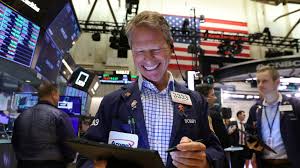
The stock market is a dynamic system that reflects the economic health of a country and the confidence of its investors. Over time, it experiences peaks and troughs, but a comeback signifies renewed optimism and growth potential. In this article, we will explore the reasons for a stock market comeback, the key players involved, and the broader implications for investors and the global economy.
Understanding a Stock Market Comeback
A stock market comeback refers to a period of recovery following a downturn. This can occur after a recession, a market correction, or a financial crisis. The term is often used to describe a return to previous market levels or a shift from negative to positive performance.
Several factors can contribute to a comeback, including economic stimulus measures, improved corporate earnings, investor confidence, and positive geopolitical developments.
Historical Examples of Stock Market Comebacks
There have been notable instances of stock market comebacks throughout history:
Post-Great Depression Recovery (1930s): Following the 1929 stock market crash, the U.S. market began to recover in the late 1930s, spurred by government intervention through programs like the New Deal.
The Dot-Com Bubble Burst and Recovery (2000s): After the collapse of overvalued internet companies, the market regained its strength in the early 2000s, driven by growth in the tech sector and broader economic recovery.
Post-2008 Financial Crisis Comeback: The 2008 global financial crisis led to a steep decline in stock markets. However, recovery efforts, such as central bank policies and government bailouts, helped stabilize the market, leading to a strong comeback in the following years.
Factors Driving the Current Stock Market Recovery
In recent times, several factors have contributed to the resurgence of stock markets:
Economic Stimulus Packages: Governments around the world, particularly in response to the COVID-19 pandemic, introduced fiscal stimulus measures, which injected liquidity into the market and helped companies stay afloat.
Monetary Policy Interventions: Central banks, including the U.S. Federal Reserve, lowered interest rates and implemented quantitative easing policies, which made borrowing cheaper and boosted consumer and business spending.
Technological Advancements: Sectors such as technology, renewable energy, and healthcare have shown rapid growth, attracting investors and contributing to the market’s recovery.
Corporate Earnings and Mergers: Improved earnings reports from major corporations and a wave of mergers and acquisitions have created investor optimism, helping to drive up stock prices.
Sectors Leading the Comeback
Not all sectors recover at the same pace. The leading industries in recent stock market comebacks include:
Technology: Tech giants like Apple, Amazon, Microsoft, and Alphabet have been critical in driving market growth, due to their adaptability and innovation in times of crisis.
Healthcare: Companies involved in vaccine development, telemedicine, and medical research have seen significant gains during periods of market recovery.
Renewable Energy: The growing demand for sustainable solutions has pushed companies in the renewable energy space into the spotlight, driving investor interest.
Consumer Goods: With increased consumer spending, companies in the retail and goods industries are benefiting from a recovering economy and are helping lead the comeback.
Impact on Global Markets
A stock market comeback in one region often has a ripple effect across global markets. The recovery of major economies like the United States or China can lead to increased confidence in international markets, encouraging foreign investment and boosting global trade.
Emerging markets, in particular, tend to benefit from a stronger global economy, as foreign capital flows into developing countries, seeking higher returns.
Investor Sentiment During a Comeback
Investor sentiment plays a pivotal role in a stock market recovery. As markets begin to stabilize, confidence returns, leading to increased investment in equities. A positive feedback loop often forms, where rising stock prices encourage further investment, driving the market even higher.
However, investors need to remain cautious. While a market comeback can be exciting, it’s important to remember that volatility can still occur, and markets may face temporary setbacks.
Challenges to Sustaining a Stock Market Comeback
Despite positive momentum, several challenges could disrupt a stock market recovery:
Inflation: Rising prices can erode consumer purchasing power and hurt corporate profits, leading to a potential market correction.
Geopolitical Tensions: Conflicts between major economies or political instability can cause uncertainty, leading to market volatility.
Interest Rate Hikes: Central banks may raise interest rates to combat inflation, which could dampen investor enthusiasm and slow down the recovery.
Supply Chain Issues: Continued disruptions in global supply chains, particularly in sectors like manufacturing and technology, can impact company earnings and stock market performance.
What Investors Should Do During a Comeback
A stock market comeback presents unique opportunities for investors, but it also requires careful planning. Here are some strategies investors might consider:
Diversification: Spread investments across various sectors to reduce risk. While tech and healthcare may lead the comeback, having exposure to different industries can protect against downturns in specific areas.
Long-Term Focus: A stock market recovery often signals a return to growth, making it an ideal time for long-term investments. Patience and holding onto quality stocks can result in substantial gains.
Stay Informed: Monitoring market trends and staying updated on economic policies and corporate earnings can help investors make informed decisions.
A stock market comeback is a powerful indicator of economic recovery and investor confidence. While it can create new opportunities for growth, it also demands a measured approach from investors. By understanding the factors driving the recovery and remaining vigilant of potential challenges, investors can make the most of the renewed momentum in the market while safeguarding their financial future.
Subscribe to Follow Global Trends for daily global news.
Find Out How To Make Money As A Full Time Writer/Blogger Guide.
To Advertise, Advertise Your Affiliate Links on FollowGlobalTrends.com for Just $1 Per Link Per Month!
Related Articles
Malaysia Stock Market Recovery
Written By: Enyoghasi Ngozi pricillia

